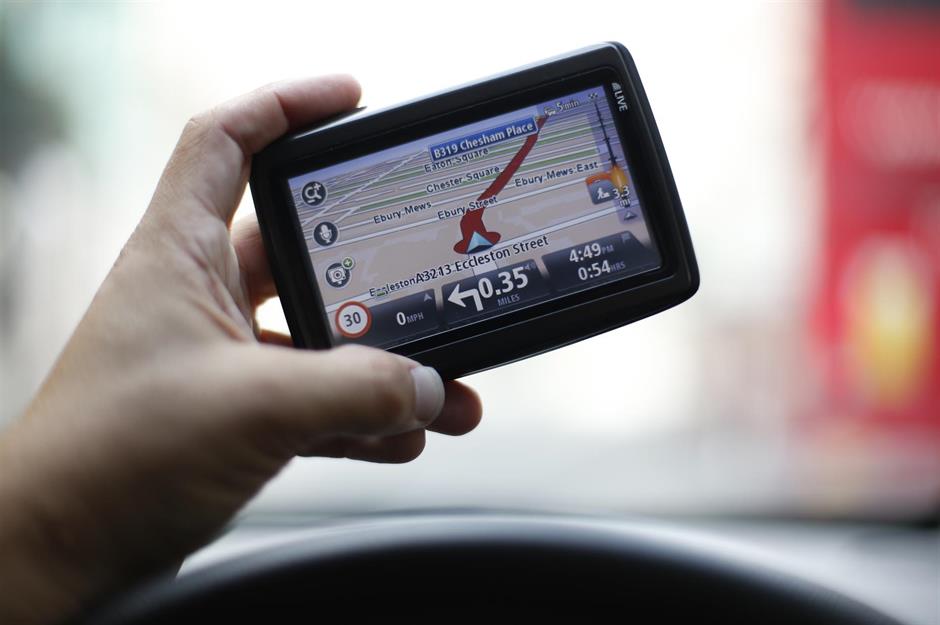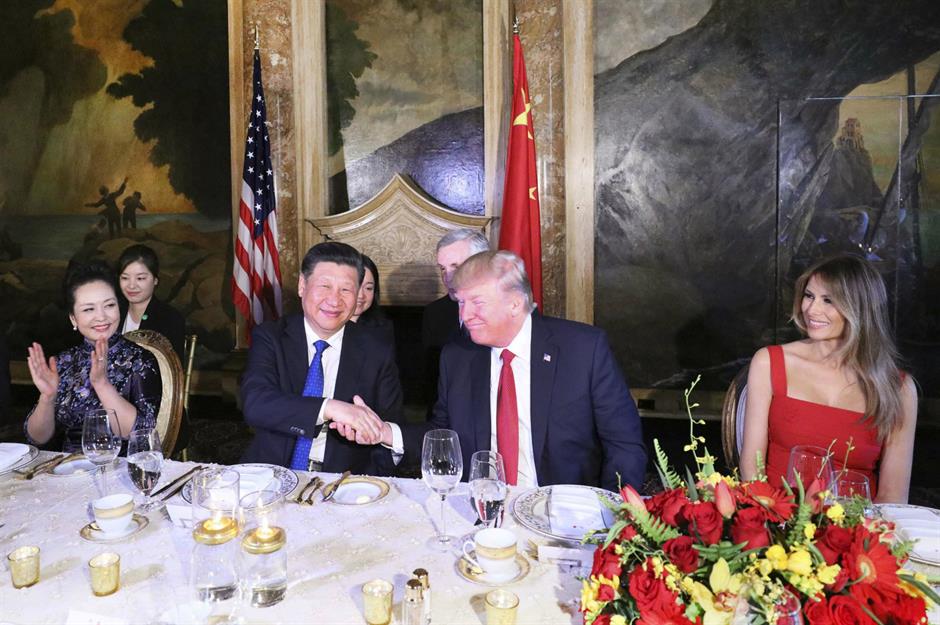From GPS to cryptocurrency, surprisingly valuable things the US government owns

Jonathan Brady/PA Archive/PA Images
Valuable things owned by the US government
From Judy Garland's Ruby Slippers to crytocurrency, and even GPS, the American government has some unusual – and expensive – assets. Here are some of the surprisingly valuable items owned by the US federal government.

Xinhua/SIPA USA/PA Images
Chinese dinner set: $16,250 (£12,460)
On a 2017 visit to the US, China's President Xi Jinping and his wife Peng Liyuan presented First Lady Melania Trump with an 85-piece dinner set valued at $16,250 (£12,460). Gifts to the First Family are automatically turned over to the State Department, which listed the plates in the set as displaying an image of Donald Trump’s Mar-a-Lago estate in Florida, where the two statesmen held their first summit in the April of that year.
Mandel Ngan/AFP/Getty Images
Saudi Order of Merit: $34,500 (£26,700)
Back in 2009, President Barack Obama received the King Abdul Aziz Order of Merit from the Saudi Arabian monarch. This medallion represented the highest honour in the Saudi kingdom and was listed on the Federal Register as a "large gold medallion with the Royal seal" alongside a "large desert scene" on a marble base and a "large brass and glass clock by Jaeger-LeCoultre", with an estimated total value of $34,500 (£26,700). The gift may have been to President Obama, but the items have to be handed over to the National Archives and Records Administration, unless the recipient pays the market value of the item to keep it.
Ruby Slippers: $2-3 million (£1.5-2.3m)
The Ruby Slippers worn by Judy Garland as Dorothy Gale in the 1939 film The Wizard of Oz are just one of the more curious items owned by the National Museum of American History, part of the government-run Smithsonian Institution in Washington DC. Several pairs were made for the movie and this set, which are mismatched, were donated by an anonymous benefactor back in 1979. However a stolen pair recovered by the FBI in September 2018 were estimated to be worth between $2-3 million (£1.5-2.3m).
Steve Parsons/PA Archive/PA Images
JFK memorial: $4.1 million (£3.2m)
Shortly after the assassination of President John F Kennedy in 1963, the UK government gave land at Runnymede, near Windsor, to the US as a tribute. "This acre of English ground" on which the memorial stands was bequeathed by the Crown in 1965 and is technically the only bit of US soil in the UK. The estimated land value of residential land in Runnymede was $10 million (£7.9m) per hectare in 2017, indicating an acre in the area had a value of about $4.1 million (£3.2m) at the time.
Jeff Kowalsky/AFP/Getty Images
Rosa Parks papers: $4.5 million (£3.5m)
Rosa Parks became known as the "mother of the civil rights movement" after she refused to give up her bus seat to a white passenger in Montgomery, Alabama, in 1955. She later moved to Detroit and worked for Michigan Congressman John Conyers. Parks died in 2005 and nearly a decade later her papers and other artefacts, including her Presidential Medal of Freedom, were purchased by the Howard G Buffett Foundation for $4.5 million (£3.5m). They were later donated to the Library of Congress.
Don Emmert/AFP/Getty Images
Stradivarius violin: $16 million (£12.3m)
The "Betts" violin by renowned Italian luthier Anton Stradivari dates back to 1704 and was donated to the Library of Congress in 1925 by Gertrude Clarke Whittall. Considered to be one of Stradivari's finest works, its construction marks the start of his golden period. The library doesn't offer an exact value, but another Stradivarius violin sold at auction for nearly $16 million (£12.3m) back in 2011.
National Portrait Gallery, Smithsonian Institution/Wikimedia Commons
George Washington painting: $20 million (£15m)
Gilbert Stuart's 1796 full-length portrait of the first US president and founding father George Washington hangs in the US National Portrait Gallery, while perhaps its most famous copy hangs in the White House. Known as the Lansdowne Portrait, it was actually hung in England for 170 years before going to the Smithsonian on long-term loan in 1968. In 2001, it was bought as a gift to the nation thanks to a $20 million (£15m) loan from the Donald W Reynolds Foundation.
Library of Congress, Rare Book and Special Collections Division
Gutenberg Bible: $35 million (£27m)
The 15th century Gutenberg Bible was one of the first major books printed in Europe using moveable metal type and is named after Johannes Gutenberg, the German inventor of the printing press. The 49 remaining copies are deemed some of the most valuable books in the world, and the one housed in the Library of Congress is one of just three perfect versions made of vellum, a fine parchment made from animal skin. Experts think a complete copy could fetch up to $35 million (£27m) at auction, if not more.
Area 51: $44 -116 million (£34-89m)
The secretive US military facility most commonly known as Area 51 has long been the basis of UFO folklore. Back in 2015, the US Air Force valued the land neighbouring the Nevada site, owned by the local Sheahan family, at $5.2 million (£3.9m), although this dropped to just $333,300 (£256,000) by the time the area was seized a year later. The Sheahans countered that the land was worth between $44 -116 million (£34-89m). The total compensation paid out remains shrouded in secrecy.
Wit Olszewski/Shutterstock
Bitcoin: $150 million ($115m)
The US government has seized about 200,000 bitcoins and still holds between 4,100 and 10,000, according to analysis by The Block. The majority (98%) of the 198,000 bitcoins seized during more than 100 criminal, civil and administrative investigations were sold for $150 million ($115m), meaning each bitcoin was sold for an average price of $780 (£598), it added in a report last November. A bitcoin is currently worth over $5,000 (£3,830).
Amtrak railway: $3.3 billion (£2.5bn) turnover
The US national rail service Amtrak was set up under the Congressional Rail Passenger Service Act of 1971, serving 43 states with 21 routes. Today, the railway travels overs more than 30 routes across 46 states. It remains heavily subsidised but last year reported revenues of $3.3 billion (£2.5bn), its best performance in decades. But while Amtrak doesn't generate profits, it does own valuable real estate in terms of stations like Penn Station in New York, where land costs $1,773 (£1,360) per square foot.
Luke Sharrett/Getty Images
Fort Knox: $6.2 billion (£4.8bn)
The US Bullion Depository, commonly known as Fort Knox, is a fortified vault in Kentucky that stores much of the country's official gold reserves. To be precise, it currently holds 147.3 million ounces of gold bullion, with a book value of $6.2 billion (£4.8bn), according to government figures. Other items that have been housed in this seemingly impenetrable fortress include a copy of the Magna Carta, an enormous cache of painkillers ahead of the Cold War and the Holy Crown of Hungary.
NASA: $21 billion ($16bn)
Created in 1958, NASA – or the National Aeronautics and Space Administration, to give it its full title – is the US government agency responsible for space exploration and aeronautics research. Its budget for the fiscal year 2020 is $21 billion ($16bn), which may seem high but accounts for just 0.4% of $4.7 trillion ($3.6tn) federal budget. And it appears to be money well spent as the Space Foundation estimates that every dollar spent on NASA adds $10 (£7.70) to the US economy.
This is what politicians get paid around the world
Jonathan Brady/PA Archive/PA Images
GPS: $37.9 billion (£29bn)
Despite its global ubiquity, the Global Positioning System (GPS) technology that drives sat-navs is actually owned by the US government and operated by the US Air Force. The GPS market size was in 2017 estimated to be $37.9 billion (£29bn) and this is expected to reach a massive $146.4 billion (£112bn) by 2025 thanks to increasing smartphone ownership and a rising number of GPS-enabled vehicles, according to Grand View Research.
Vadim Sadovski/Shutterstock
International Space Station: share of $150 billion (£115bn)
The International Space Station (ISS) is a collaborative project between the US, Russia, Europe, Canada and Japan. First launched in 1998, it has been continuously occupied since November 2000 and makes 16 orbits of Earth each day. The $150 billion (£115bn) ISS costs NASA between $3-$4 billion (£2.3bn-£3.1bn) in maintenance each year and the US, like all other partners, gets to exercise its jurisdiction over the elements it provides.
Abandoned projects the US government spends billions of taxpayers' money on
US Postal Service: $1.4 trillion (£1.1tn)
The US Postal Service (USPS) is one of the few government agencies authorised by the US Constitution. The USPS is at the heart of an $1.4 trillion (£1.1tn) domestic mailing industry that employs over 7.5 million people, but receives no tax dollars for its operating expenses and instead relies on sales to fund its operations. However, in 2018 it posted its 12th year of net losses at $3.9 billion (£3bn), that's more than a billion dollar increase on the previous year.
Student loans: $1.5 trillion (£1.15tn)
Student loans are the single biggest asset in the US government's financial accounts. About 44 million Americans owed a total of $1.5 trillion (£1.15tn) in student debt last year, according to Forbes. This means that student loans made up a whopping 45% of all of the US government's financial assets in the first quarter of 2018.
Tracy Barbutes/Zuma Press/PA Images
Federal land: $130 trillion (£120tn)
One of the US's greatest assets is its land. The federal government owns 28% of the 2.27 billion acres that makes up the US, and 47% of all land in the west. In addition, the Institute for Energy Research estimated in 2013 that the US government's net worth of natural resources was at least $130 trillion (£120tn) – a figure which vastly eclipses the current $22 trillion ($17tn) federal debt.
Controversial ways the US government spends taxpayers' money

